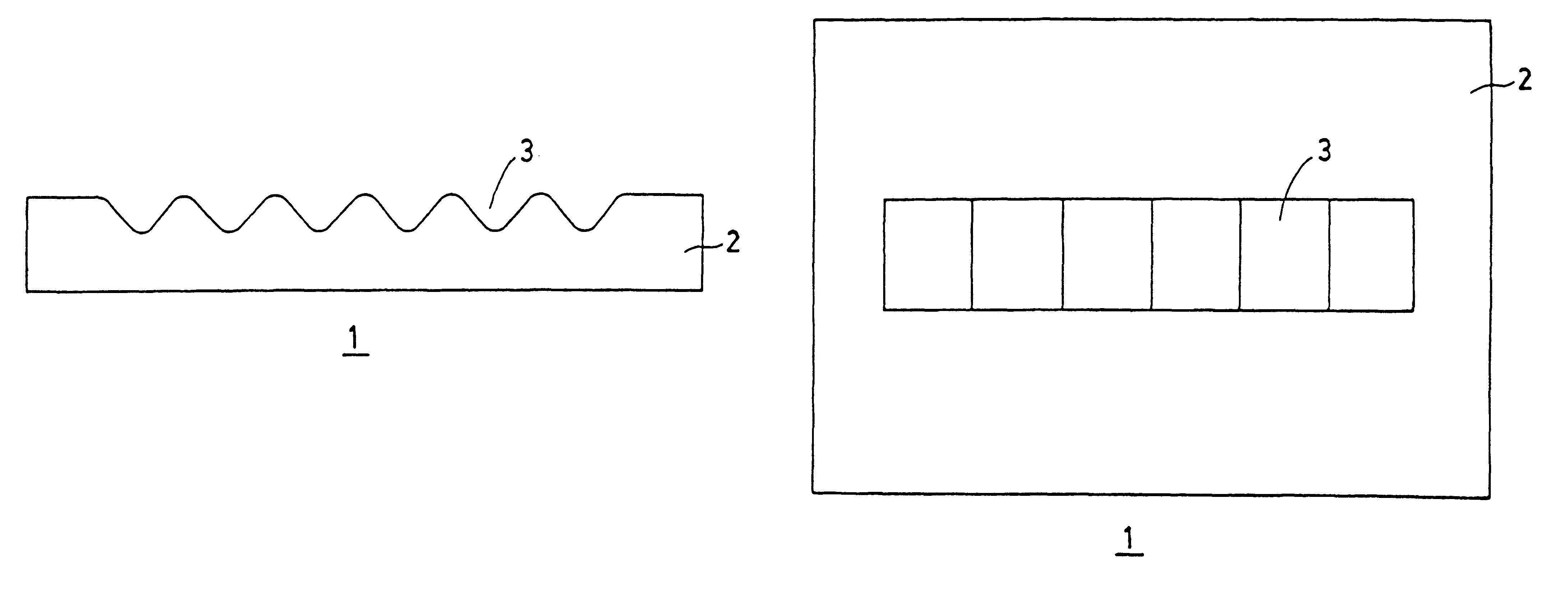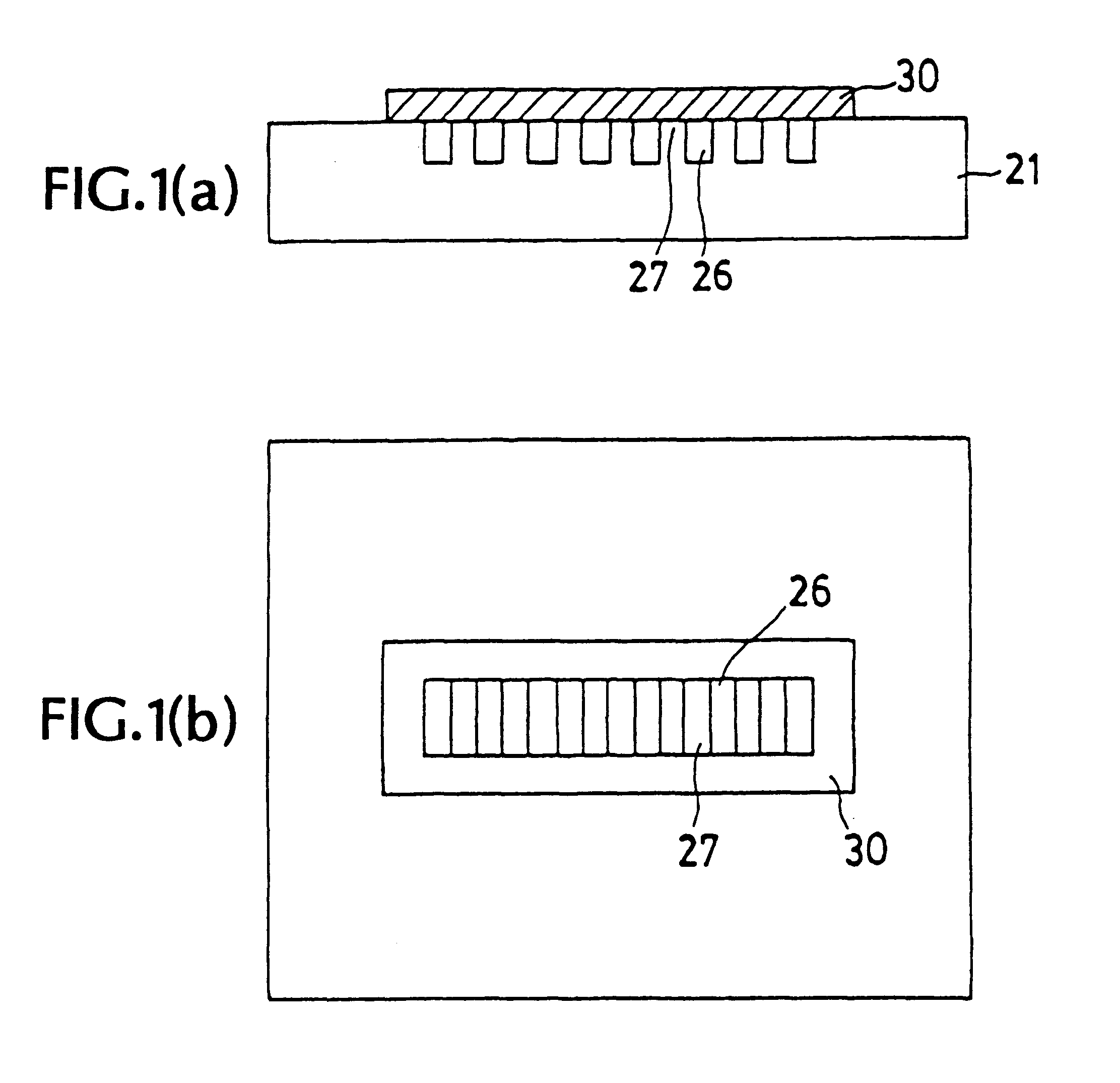Phase mask for manufacturing diffraction grating, and method of manufacture
a technology of diffraction grating and phase mask, which is applied in the field of diffraction gratingforming phase mask, can solve the problems of high manufacturing cost, low yield, and difficulty in making such a minute structure in the optical fiber cor
- Summary
- Abstract
- Description
- Claims
- Application Information
AI Technical Summary
Problems solved by technology
Method used
Image
Examples
example 1
FIG. 5(a) to FIG. 5(h) are sectional views of one embodiment of the process of fabricating the aforesaid phase mask 1. In these figures, reference numeral 5 represents a phase mask blank, 2 a quartz substrate, 4 a chromium thin film, 4A a chromium thin-film pattern, 4B an opening in the chromium thin film, 6 an electron-beam resist, 6A a resist pattern, 6B a resist opening, 14 an electron beam, 1 a phase mask, 3 a groove of a sine wave shape in section, 3' a groove of a rectangular wave shape in section, 8 a strip of a sine wave shape in section, and 8' a strip of a rectangular wave shape in section.
As shown in FIG. 5(a), the blank 5 was first prepared by forming the chromium thin film 4 of 20 nm in thickness on the quartz substrate 2 by sputtering. The chromium thin film 4 is useful for preventing a charging-up of the electron-beam resist 6 at the electron-beam (6) irradiation step, and serves as a mask in the formation of the groove 3' on the quartz substrate. The thickness of thi...
example 2
In this example, steps (a) to (b) are the same as those shown in FIGS. 5(a) to 5(d) for Example 1. That is, the blank 5 was first prepared by forming the chromium thin film 4 of 20 nm in thickness on the quartz substrate 2 by sputtering, as shown in FIG. 5(a).
Then, electron-beam resist RE5100P (made by Hitachi Kasei Co., Ltd.) as the electron-beam resist 6 was coated on the chromium thin film to a thickness of 400 nm, and dried, as shown in FIG. 5(b).
After this, the electron-beam resist 6 was exposed to light at an exposure of 1.2 .mu.C / cm.sup.2, as shown in FIG. 5(c), using an electron-beam writing system MEBESIII (made by ETEC), so that portions corresponding to the groove 3' were exposed to the electron beams 7.
After the exposure, post-exposure baking (PEB) was carried out at 90.degree. C. for 5 minutes, and the electron-beam resist 6 was developed with TMAH (tetramethylammonium hydroxide) at a concentration of 2.38%, thereby forming such desired resist pattern 6A as shown in FIG...
example 3
Using the method as already explained, a transparent protective layer 30 was applied over the surface of the transparent substrate (FIG. 1) fabricated according to the FIG. 5 or 6 fabrication process. The section of the repetitive groove (26)-and-strip (27) pattern shown in FIG. 1 was in a substantially sine wave shape, as can be seen from the phase mask fabricated according to the FIG. 5 or 6 fabrication method. The transparent protective layer 30 was applied with respect to this phase mask, thereby covering the surface of the transparent substrate shown in FIG. 1.
PUM
 Login to View More
Login to View More Abstract
Description
Claims
Application Information
 Login to View More
Login to View More - R&D
- Intellectual Property
- Life Sciences
- Materials
- Tech Scout
- Unparalleled Data Quality
- Higher Quality Content
- 60% Fewer Hallucinations
Browse by: Latest US Patents, China's latest patents, Technical Efficacy Thesaurus, Application Domain, Technology Topic, Popular Technical Reports.
© 2025 PatSnap. All rights reserved.Legal|Privacy policy|Modern Slavery Act Transparency Statement|Sitemap|About US| Contact US: help@patsnap.com



